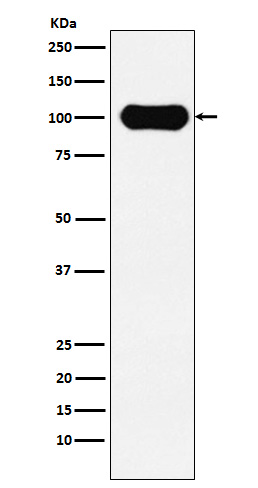产品名称
FE65 (4V18) Rabbit Monoclonal Antibody
别名
APBB1; Protein Fe65; RIR;
纯度
Affinity-chromatography
存储缓冲液
Supplied in 50mM Tris-Glycine(pH 7.4), 0.15M NaCl, 40%Glycerol, 0.01% New type preservative N and 0.05% BSA.
Human Swissprot No.
O00213
免疫原
A synthetic peptide of human FE65
稀释度
WB: 1:1000 IHC: 1:201:20
注意事项
FE65 Antibody is for research use only and not for use in diagnostic or therapeutic procedures.
组织表达
Highly expressed in brain; strongly reduced in post-mortem elderly subjects with Alzheimer disease
细胞定位
Cell membrane. Cytoplasm. Nucleus. Cell projection, growth cone. Nucleus speckle Note=Colocalizes with TSHZ3 in axonal growth cone (By similarity). In normal conditions, it mainly localizes to the cytoplasm, while a small fraction is tethered to the cell membrane via its interaction with APP Following exposure to DNA damaging agents, it is released from cell membrane and translocates to the nucleus. Nuclear translocation is under the regulation of APP. Colocalizes with TSHZ3 in the nucleus Colocalizes with NEK6 at the nuclear speckles. Phosphorylation at Ser- 610 by SGK1 promotes its localization to the nucleus (By similarity)
功能
Transcription coregulator that can have both coactivator and corepressor functions. Adapter protein that forms a transcriptionally active complex with the gamma-secretase-derived amyloid precursor protein (APP) intracellular domain. Plays a central role in the response to DNA damage by translocating to the nucleus and inducing apoptosis. May act by specifically recognizing and binding histone H2AX phosphorylated on 'Tyr-142' (H2AXY142ph) at double-strand breaks (DSBs), recruiting other pro-apoptosis factors such as MAPK8/JNK1. Required for histone H4 acetylation at double-strand breaks (DSBs). Its ability to specifically bind modified histones and chromatin modifying enzymes such as KAT5/TIP60, probably explains its transcription activation activity. Functions in association with TSHZ3, SET and HDAC factors as a transcriptional repressor, that inhibits the expression of CASP4. Associates with chromatin in a region surrounding the CASP4 transcriptional start site(s). Involved in hippocampal neurite branching and neuromuscular junction formation, as a result plays a role in spatial memory functioning (By similarity). Plays a role in the maintenance of lens transparency (By similarity). May play a role in muscle cell strength (By similarity).

